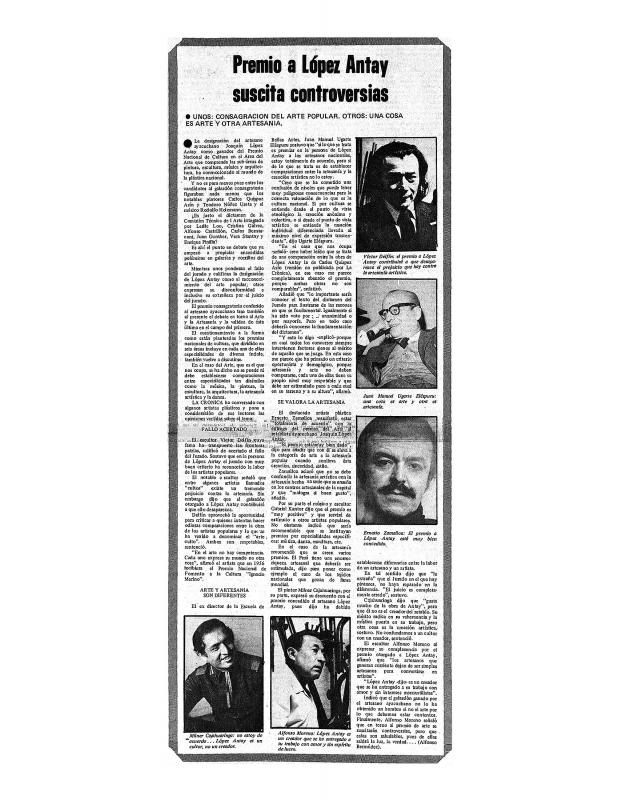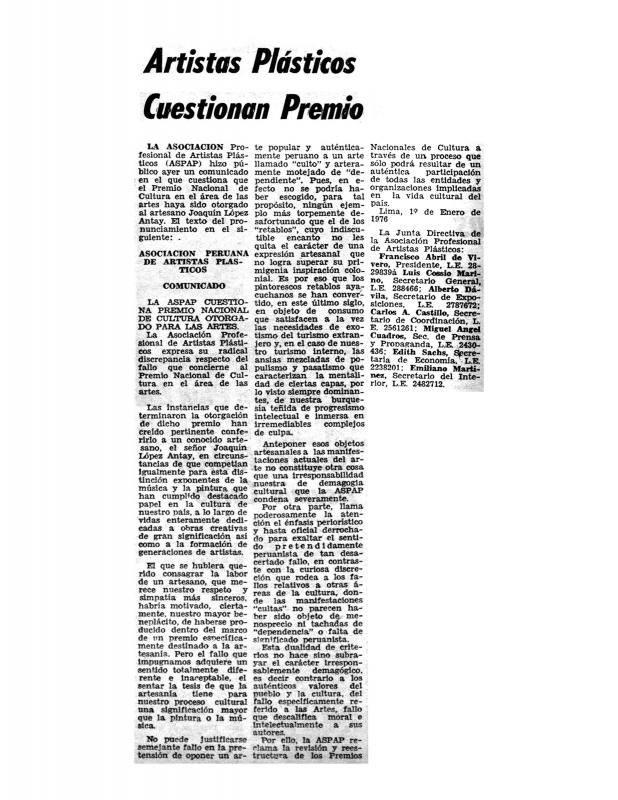This is a review of recent news about Villa El Salvador, the largest “pueblo joven” [young town] (slum) in Lima. The article calls on the residents of the Villa to take responsibility for their own development, as in their electoral process, insisting that it is not necessary to resort to an authoritarian form of vertical hierarchy. The article was published in La Jornada Comunera, a supplement of La Prensa, the newspaper that had spoken to the Peruvian working class since it was expropriated on July 27, 1974, by the military government led by General Juan Velasco Alvarado (1968–75). The newspaper column conveys a sense of the controversial situation created when the Dutch artist Karel Appel (1921–2006) visited the Villa El Salvador community.
Appel came to Lima because he was attracted by the social changes taking place in Peru as a result of the profound reforms dictated by the government of General Velasco. He was planning to work in a recently created shantytown that was originally promised self-rule by the regime. He worked with residents to paint a mural that would eventually be forgotten and utterly allowed to deteriorate. He arrived in Peru during the debate about the supposed boundaries between “fine” and “popular” art that erupted in late 1975, when the Premio Nacional de Cultura was awarded to a creator of altar pieces, the artisan Joaquín López Antay (1897–1981). When Appel complimented the artisan, his words were well received by those who supported the prize, but they provoked a violent backlash from those who were opposed to such an acknowledgment.
[Regarding the Premio Nacional de Cultura, see the following documents in the ICAA digital archive: by Alfonso Castrillón, Leslie Lee, and Carlos Bernasconi “Fundamentación para el dictamen por mayoría simple a favor del artista popular Joaquín López Antay” (doc. no. 1135896); by Alfonso Bermúdez “Premio a López Antay suscita controversias. Unos: consagración del arte popular. Otros: una cosa es arte y otra artesanía” (doc. no. 1135879); by Francisco Abril de Vivero, Luis Cossío Marino, and Alberto Dávila “Artistas plásticos cuestionan premio” (doc. no. 1135960); and (unattributed) “‘No todos nos quieren ni en Lima ni en Ayacucho’: así comentó sobre cuestionamiento a premio” (doc. no. 1135930)].
[As complementary reading on Karel Appel, see the following articles in the archive: (unattributed) “El retablo es ‘Folclor Dadá’ y es arte, opinó plástico holandés Karel Appel: ‘lo que vio en la Escuela de Artes Plásticas no era arte’ dijo” (doc. no. 865535); by Appel “Villa El Salvador: Kerouaciana” (doc. no. 1052138); (unattributed) “Pobladores de Villa El Salvador pintarán murales en la calle dirigidos por el artista Appel” (doc. no. 865645); by Luis Freire Sarria “La Cobra en Villa El Salvador (I)” (doc. no. 865607); (unattributed) “El pueblo muralista” (doc. no. 865664); and by Fietta Jarque “¿Mural que muere?: en Villa El Salvador” (doc. no. 865683)].










